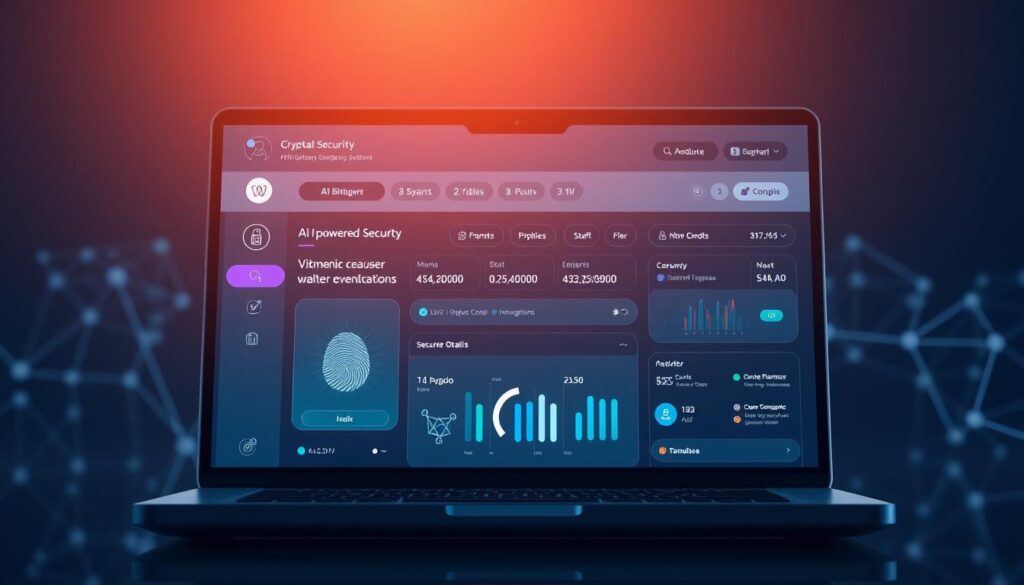Now Reading: Discover AI Powered Crypto Wallet Security Features
- 01
Discover AI Powered Crypto Wallet Security Features
Discover AI Powered Crypto Wallet Security Features

The landscape of digital finance is undergoing a dramatic transformation. Traditional methods for safeguarding digital assets are no longer sufficient against evolving threats. This guide explores the next generation of protection for your investments.
In 2024 alone, over $2.2 billion in cryptocurrency was stolen. A shocking 40% of these losses stemmed from compromised private keys. This highlights a critical need for smarter, more proactive solutions.
Artificial intelligence is now being integrated directly into storage applications. These systems act as intelligent co-pilots. They learn your habits, spot dangers in real-time, and offer personalized advice.
The fintech sector is investing heavily in this technology. Market projections show massive growth, from $14.79 billion in 2024 to a projected $43.04 billion by 2029. This signals a strong shift towards intelligent asset management tools for users today.
Key Takeaways
- Traditional digital asset storage is becoming outdated against modern threats.
- Intelligent systems now offer proactive protection by learning user behavior.
- Private key compromise was a leading cause of major financial losses in 2024.
- The integration of advanced algorithms creates a more secure user experience.
- Massive industry investment is driving the rapid development of these new solutions.
- This technology benefits everyone from individual investors to fintech entrepreneurs.
Introduction to AI in Crypto Wallets
Modern investors demand more sophisticated tools for managing their blockchain-based holdings. Traditional storage solutions function like basic safes, placing all responsibility on the user.

These conventional systems require constant vigilance against threats. Users must make complex security decisions without adequate guidance.
The integration of intelligent systems represents a fundamental shift. Instead of passive containers, these tools become active guardians of digital assets.
This evolution addresses two critical challenges simultaneously. It combats sophisticated cyber threats while improving the overall interaction for holders.
People accustomed to streamlined financial applications expect similar simplicity. Complex interfaces and technical jargon often drive them away from blockchain technology.
| Feature Type | Traditional Approach | Intelligent Approach |
|---|---|---|
| Threat Response | Reactive protection after incidents occur | Proactive monitoring and prevention |
| User Guidance | Minimal assistance with technical decisions | Personalized recommendations and warnings |
| Transaction Management | Manual verification for every operation | Automated optimization based on patterns |
| Learning Capability | Static functionality without adaptation | Continuous improvement through behavior analysis |
This technological advancement represents the most significant development since Bitcoin’s creation. It transforms basic storage into comprehensive management partners.
Understanding AI Powered Crypto Wallet Security Features
Intelligent systems are revolutionizing how we protect blockchain-based investments through proactive monitoring. These advanced tools move beyond basic storage to become active guardians of digital assets.

Machine learning algorithms analyze vast amounts of historical transaction data. They identify patterns associated with fraudulent activities before damage occurs.
Anomaly detection establishes normal behavior baselines for each account holder. The system immediately flags unusual activities like unexpected transaction amounts or unfamiliar recipient addresses.
Smart contract simulation technology provides an additional safety layer. It executes test runs in isolated environments, showing potential outcomes in simple language before final approval.
| Detection Method | How It Works | Primary Benefit |
|---|---|---|
| Behavioral Biometrics | Learns typing patterns, device handling, and activity schedules | Identifies unauthorized access through behavioral mismatches |
| Real-Time Threat Scanning | Continuously checks against databases of known exploits | Provides 24/7 protection against emerging threats |
| Pattern Recognition | Analyzes transaction histories for suspicious patterns | Prevents fraud before financial losses occur |
| Smart Contract Analysis | Simulates interactions in safe environments | Protects against poorly coded or malicious contracts |
Behavioral profiling creates unique digital fingerprints based on how individuals interact with their devices. This technology triggers additional verification when unusual patterns suggest potential compromise.
These interconnected capabilities form multiple protective layers that adapt over time. The system learns from new threats across the entire network, creating increasingly effective safeguards.
Evolution of Crypto Wallets and AI Integration
Early digital asset holders faced limited options for managing their blockchain investments. They relied on rudimentary software solutions that emerged alongside Bitcoin in 2009.
These initial tools focused solely on generating and protecting private keys. Basic functionality was restricted to simple send and receive operations on single networks.

As the cryptocurrency ecosystem expanded beyond Bitcoin, storage solutions evolved significantly. Wallets began supporting multiple digital assets with more sophisticated interfaces.
Security demands drove major architectural innovations during this development phase. Multi-signature authentication required multiple private keys for transaction approval. Hierarchical deterministic structures generated new addresses from single seed phrases.
The integration of intelligent systems represents the latest evolutionary leap. This advancement addresses persistent challenges that incremental improvements couldn’t solve.
Modern examples demonstrate this transformation effectively. TRC20 storage solutions on the TRON network show how enhancement improves transaction speed. MPC technology utilizes multi-party computation for protection, complemented by real-time threat detection capabilities.
This integration isn’t merely an add-on feature but a fundamental reimagining. Storage tools transform from passive containers into active financial management platforms.
The Role of Artificial Intelligence in Safeguarding Digital Assets
The integration of sophisticated algorithms creates a new paradigm for digital asset protection. These intelligent systems move beyond static rules to offer dynamic, evolving safeguards that learn from each interaction.

Machine Learning for Enhanced Security
Advanced computational models analyze vast datasets of transaction histories and user behaviors. They identify subtle anomalies that might indicate emerging threats before financial losses occur.
These systems continuously refine their detection capabilities as they process more information. The protection becomes stronger over time rather than becoming outdated.
Adaptive Risk Management
Intelligent technology assesses entire portfolio compositions against market conditions and personal risk tolerance. It evaluates asset volatility and correlation patterns to maintain balanced holdings.
The system can suggest rebalancing strategies during market volatility. It alerts users when their investments drift outside comfortable risk parameters.
This personalized approach considers individual transaction histories and behavioral patterns. Unlike uniform security rules, it tailors protection strategies to each user’s specific needs.
The technology functions as a personalized risk management advisor. It helps mitigate potential losses while capitalizing on emerging opportunities.
Enhanced Fraud Detection and Threat Prevention
The battle against financial fraud has entered a new era with intelligent monitoring capabilities. These systems analyze massive volumes of transaction data to identify suspicious patterns that human oversight might miss.
Machine learning algorithms establish normal behavior baselines for each account holder. They track typical transaction amounts, frequencies, and recipient addresses over extended periods.
Anomaly Detection Techniques
Advanced systems flag deviations from established patterns immediately. A wallet that normally transfers small amounts weekly would trigger alerts if suddenly initiating large transfers to unknown international addresses.
These techniques identify sophisticated attack patterns including account takeover attempts and money laundering schemes. The system learns from industry-wide security failures to recognize threat signatures.
Real-Time Fraud Alerts
Continuous monitoring analyzes every transaction against multiple threat indicators simultaneously. This includes known malicious addresses and suspicious smart contract interactions.
The technology blocks suspect login attempts from known-bad IP addresses automatically. It evolves its understanding of malicious patterns without requiring manual updates.
| Detection Method | Primary Function | Response Time |
|---|---|---|
| Behavioral Pattern Analysis | Identifies deviations from normal user activity | Immediate flagging |
| Threat Database Cross-Reference | Checks against known malicious addresses | Real-time blocking |
| Transaction Anomaly Detection | Spots unusual amounts or timing | Pre-transaction verification |
| Automated Pattern Learning | Incorporates new attack vectors | Continuous improvement |
This proactive approach represents a significant advancement over traditional rule-based systems. It provides dynamic protection that adapts to emerging threats in the digital landscape.
Optimizing Transactions with Predictive Analytics
The unpredictable nature of network fees creates constant uncertainty for anyone moving digital assets between platforms. Traditional interfaces offer basic fee settings that often lead to overpayment or delayed confirmations.
Advanced analytics transform this experience by predicting optimal transaction conditions. These systems analyze real-time network data and historical patterns to provide precise recommendations.
Instead of guessing between low, medium, or high fee options, users receive specific guidance. The technology might suggest waiting thirty minutes when fees are projected to drop significantly.
This approach extends beyond simple fee optimization to strategic timing. The system evaluates market conditions and network congestion across multiple chains.
| Transaction Aspect | Traditional Method | Predictive Approach |
|---|---|---|
| Fee Selection | Basic low/medium/high options | Precise cost predictions with timing |
| Confirmation Time | Unpredictable based on fee choice | Accurate timeframe estimates |
| Network Analysis | Manual checking required | Continuous monitoring and alerts |
| Cost Optimization | Trial and error approach | Data-driven recommendations |
For decentralized finance activities, these analytics identify optimal windows for yield farming or asset transfers. The technology considers both immediate costs and long-term strategy.
This represents a significant advancement in user experience. Transaction management becomes more efficient and cost-effective through intelligent data analysis.
Building Trust Through Robust Wallet Security Solutions
Trust forms the foundation of any successful financial tool, especially those handling valuable digital holdings. Users need to see clear evidence of protection before committing their assets to any platform.
Modern solutions combine traditional methods like multi-factor authentication with behavioral analysis. This creates systems that verify not just what you know, but how you typically interact with your account.
Transparency plays a crucial role in establishing confidence. Leading providers publish detailed documentation about their protection architecture. They undergo regular third-party audits to verify their claims.
The integration of machine learning must be understandable to users. People should know how their data gets analyzed and what patterns trigger alerts. This prevents the technology from becoming an opaque “black box” system.
| Trust Factor | Basic Approach | Advanced Approach |
|---|---|---|
| Verification Methods | Single password protection | Multi-layer authentication with behavioral checks |
| Transparency | Limited security information | Published audits and clear communication protocols |
| Threat Response | Reactive incident handling | Proactive monitoring and rapid update deployment |
| Interoperability | Proprietary isolated systems | Integration with established protection ecosystems |
Interoperability demonstrates commitment to industry standards rather than proprietary isolation. Connecting with hardware security modules and blockchain authentication systems shows serious dedication to protection.
Proven performance over time ultimately determines trustworthiness. Providers establish reputations through consistent updates and minimal incident rates. The advanced protection benefits become evident through transparent handling of any security events that occur.
These overlapping layers create environments where users feel confident managing their digital assets. The enhanced monitoring capabilities work quietly in the background while maintaining clear communication with account holders.
User-Centric Design and Personalized Wallet Experiences
The most successful digital asset management tools prioritize intuitive interfaces that welcome all skill levels. This design philosophy recognizes that complex systems fail when they confuse mainstream users. Even the most advanced protection becomes useless if people cannot navigate basic functions comfortably.
Modern platforms now deliver unprecedented personalization through intelligent learning systems. These tools analyze individual habits and preferences to customize dashboard layouts. Traders see market analytics prominently displayed while long-term holders view staking opportunities first.
Machine learning algorithms identify repetitive actions and suggest helpful automations. The system might notice monthly transfer patterns and offer to schedule recurring transactions. This creates significant time savings while reducing potential errors during manual entries.
Natural language processing transforms technical interactions into simple conversations. Users can type commands like “Send $100 to mom on Polygon” instead of navigating complex menus. The system handles network selection and token conversion automatically behind the scenes.
These personalized experiences extend to educational support and risk communication. The assistant provides context-aware explanations for terms like staking while checking eligibility. It adapts warning language based on each user’s demonstrated understanding level.
Implementing AI in Crypto Wallet Development
The convergence of distributed ledger technology and artificial intelligence presents unique challenges for developers creating next-generation financial applications. This integration demands specialized knowledge across multiple technical domains.
Choosing the Right Development Partner
Selecting a qualified team requires careful evaluation of their track record. Proven experience in both blockchain architecture and machine learning implementation is essential. Companies like IdeaSoft and PixelPlex demonstrate this multidisciplinary approach.
These partners combine established blockchain development services with dedicated AI teams. They understand how to build secure, intelligent solutions that meet enterprise-grade requirements.
Integrating AI with Secure Coding Practices
The architectural design must maintain strict separation between advisory functions and transaction execution. Advanced algorithms should operate without direct access to private keys or signing capabilities.
Critical decisions involve processing location—on-device for privacy or cloud environments for power. Secure coding practices ensure cryptographic implementations meet industry audit standards. This approach creates robust protection while delivering advanced functionality.
Navigating Compliance and Regulatory Challenges
Compliance requirements vary dramatically across international jurisdictions, creating complex challenges for digital asset management tools. Developers must satisfy cryptocurrency rules, financial service mandates, and emerging governance frameworks simultaneously.
Global operations face contradictory demands. Some regions require extensive data retention while others enforce strict privacy protections. This creates significant operational hurdles for applications serving international users.
Financial authorities increasingly demand transparent decision-making processes. Advanced computational models must provide clear reasoning for their actions to satisfy audit requirements. This technical demand adds complexity to development.
Anti-money laundering compliance becomes more sophisticated with intelligent integration. Systems autonomously identify suspicious patterns but must maintain thorough documentation. Data privacy regulations like GDPR require careful architectural design.
Ethical considerations around algorithmic bias demand ongoing monitoring. Successful developers maintain multidisciplinary expertise and close regulatory relationships. They implement compliance-by-design approaches throughout development.
Leveraging Blockchain Integration for Secure Wallets
The foundation of secure digital asset management rests on seamless blockchain integration. Modern storage solutions must connect with multiple distributed ledger networks simultaneously.
These systems handle assets across Ethereum, Bitcoin, and dozens of other platforms. Each network has unique consensus mechanisms and technical requirements.
Multi-chain functionality presents significant technical challenges. Machine learning algorithms must process data from heterogeneous sources while maintaining protection isolation.
Scalability becomes critical when combining advanced analytics with distributed ledger technology. Both systems demand substantial computational resources as transaction volumes grow.
Specialized networks like the XDC Network demonstrate optimized integration. Enhanced algorithms leverage fast processing speeds and network-specific protection capabilities.
Asset-backed digital currencies benefit from intelligent monitoring systems. These tools track collateralization ratios and provide stability risk analysis.
Successful implementation requires abstraction layers that respect each protocol’s unique characteristics. This approach ensures consistent functionality across diverse blockchain environments.
Market Trends and Future Prospects in AI Wallets
Analysts project remarkable growth trajectories for smart financial tools that combine algorithmic learning with blockchain infrastructure. The market for these advanced solutions shows compound annual growth rates exceeding 23% for the coming decade.
Current integration remains in early stages despite rapid advancement. Most existing platforms implement specific capabilities rather than comprehensive management ecosystems.
Future development will emphasize deeper connections with decentralized finance protocols. This includes automated strategies for yield optimization and liquidity management.
Virtual assistants represent an emerging trend that democratizes access to sophisticated strategies. These tools translate complex concepts into conversational guidance for all users.
Behavioral biometrics will evolve beyond current implementations. Future systems create comprehensive user profiles that detect compromises with minimal false positives.
The quantum computing challenge presents both threat and opportunity. Research explores quantum-resistant algorithms to future-proof digital asset protection.
Market consolidation suggests intelligent capabilities will differentiate successful platforms. Users gravitate toward solutions offering tangible improvements over traditional alternatives.
Comparative Analysis: AI Wallets vs Traditional Wallets
Choosing between different digital asset management approaches requires understanding their fundamental differences in philosophy and capability. Traditional tools primarily function as secure key storage systems with basic transaction capabilities.
These conventional options place full responsibility for protection decisions on account holders. Users must manually research optimal fees and verify contract safety.
Enhanced alternatives incorporate sophisticated algorithms that actively monitor and analyze asset management. They provide personalized recommendations and automated optimizations based on individual behavior patterns.
Security comparisons reveal stark differences between static and adaptive protection mechanisms. While traditional methods rely on password authentication, modern systems add behavioral analysis and predictive threat detection.
User experience represents perhaps the most significant differentiation. Standard tools offer consistent functionality to everyone regardless of expertise level. Intelligent systems personalize interfaces and automation based on demonstrated preferences and patterns.
The distinction between storage tools and trading platforms becomes important here. Enhanced management solutions focus on secure custody while exchanges prioritize trading functionality.
Cost-benefit analysis increasingly favors sophisticated alternatives despite potentially higher development expenses. The reduction in user errors and prevented breaches typically offsets any premium pricing quickly.
Key Considerations for Buyers in the AI Wallet Market
The process of selecting appropriate digital currency storage involves weighing several critical considerations simultaneously. Buyers must balance multiple factors to find solutions matching their specific requirements.
Protection evaluation extends beyond basic authentication methods. Advanced systems offer comprehensive monitoring that learns from user behavior patterns. This creates personalized safeguards against emerging threats.
Interface design significantly impacts daily usage. Tools should simplify complex operations while maintaining robust functionality. Personalization capabilities adapt displays to individual preferences.
Multi-currency support becomes essential as portfolios expand. Versatile applications handle various digital assets across different blockchain networks. This flexibility accommodates evolving investment strategies.
| Consideration | Basic Requirement | Advanced Feature |
|---|---|---|
| Protection Level | Standard authentication | Behavior-based monitoring |
| User Experience | Simple navigation | Personalized interfaces |
| Currency Support | Major cryptocurrencies | Emerging tokens and networks |
| Cost Structure | Transparent fees | Value-added services |
| Provider Reputation | Positive reviews | Third-party audits |
Fee analysis requires understanding total ownership expenses. Transaction charges, subscription costs, and hidden fees impact overall returns. Competitive pricing ensures value preservation.
Provider research investigates development expertise and customer support quality. Established companies demonstrate transparency through regular security audits. This builds trust in their digital asset management solutions.
Strategic Partnerships and AI Innovation in Wallet Development
Forward-thinking companies are discovering that building next-generation financial tools requires combining specialized expertise across several technical domains. Strategic alliances have become essential for delivering sophisticated functionality efficiently.
The complexity of modern financial technology development demands multidisciplinary teams. Few organizations maintain cutting-edge capabilities across blockchain architecture, machine learning, and regulatory compliance simultaneously.
Leading specialists like IdeaSoft demonstrate the value of integrated expertise. Their established blockchain development services combine with dedicated technical capabilities to create robust solutions.
Firms such as PixelPlex bring extensive experience building complex systems. Their first-principle engineering approach solves novel challenges that lack established patterns.
Development partnerships provide access to proven architectures and reusable components. This accelerates time-to-market while reducing implementation risks.
The strategic model allows companies to focus on core competencies like user experience design. They leverage specialized partners for technical implementation of advanced features.
Conclusion
The relationship between users and their digital holdings transforms through continuous learning systems. These intelligent tools represent more than incremental upgrades—they fundamentally redefine asset management.
Current evidence clearly demonstrates the superiority of modern solutions. Enhanced detection capabilities and personalized guidance create measurably better outcomes compared to traditional approaches.
Future development will bring even smarter automation and cross-chain functionality. The market trajectory shows rapid adoption as these tools become mainstream expectations.
For anyone evaluating options today, the advantages justify careful consideration. These advanced systems offer superior protection and more effective management for long-term success.
FAQ
How does machine learning improve wallet protection?
Machine learning algorithms analyze transaction patterns and user behavior to identify potential threats. This system learns over time, becoming more effective at spotting fraud and unauthorized access attempts.
What are real-time fraud alerts?
These are instant notifications sent to you when the system detects suspicious activity. This allows you to take immediate action to secure your digital assets against potential attacks.
Can predictive analytics help with transaction fees?
Yes. By analyzing network data and market trends, predictive analytics can suggest optimal times for transactions. This helps in managing costs associated with blockchain exchanges.
What should I look for in a development partner for an intelligent wallet?
Seek a partner with proven expertise in both blockchain integration and artificial intelligence. Their experience in secure coding practices and regulatory compliance is crucial for a successful project.
How does adaptive risk management work?
This feature continuously assesses the risk level of each action you take. It adjusts security protocols dynamically based on the current threat landscape and your specific usage patterns.
Are these wallets more user-friendly than traditional options?
Absolutely. The integration of intelligence focuses on creating a personalized experience. It simplifies complex security measures, making management of your cryptocurrency more intuitive.
How is privacy handled with these advanced solutions?
A> User privacy is a top priority. Data analytics are designed to enhance security without compromising personal information. The model operates to protect your identity and transaction details.












